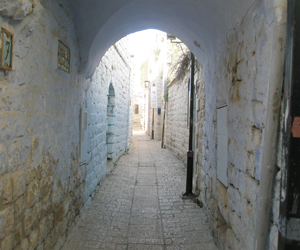The Fig Tree Courtyard
History
Throughout the history of the Jewish community in Tzfat, the safety of the residents of the town was precarious. The rulers could either be benevolent or cruel, and the neighboring Arabs, Druze and Bedouin often launched raids and massacres against the Jews. The wealthy were able to build their homes with some measure of security, and these were the buildings that their neighbors fled to when trouble arose.
One such building sits today on Alkabetz Street in Tzfat. Built with massive stone walls surrounding its courtyard and a double gate, it belonged to the wealthy Hamami family for generations. By the mid-20th century, no Hamamis remained and for decades, the massive building sat empty and dilapidated, with an occasional squatter to enjoy its history.
Local Israeli Hand-Crafted Art
As the 21st century dawned, an American investor bought the building and began to think of ways to develop it, not for his own financial gain, but to promote and develop Tzfat. The idea of the Fig Tree Gallery grew as the investor, together with local artists and artisans, gradually conceptualized a large gallery which would showcase local Israeli hand-crafted art.
The renovations were extensive, as, aside from the physical structure of the building, everything had to be torn out and replaced....walls, ceilings, flooring, plumbing, and electricity. Care was taken to attempt to retain the old Tzfat character of the building during renovations while allowing in as much light and air as possible. The courtyard, in which an old fig tree stands, became the center of the gallery, with the shops which showcase the various exhibitions surrounding the yard.
Renovations continue on the upper story of the building, where artists' workshops are planned. In the meantime, the lower gallery showcases every imaginable art type and medium, including ceramics, paper-cuts, metal sculpture, paintings glass, wood and bamboo-work, silk-painting, oil and acrylic paintings, and more. Much of the artwork which is on exhibition is Judaica, but not all, and there is a good bit of Kabbalah-inspired art work as well.
Leon Bronstein's wood sculptures are exhibited, along with the HaAri Jewelry which has drawn its inspiration from the Kabbalah study of the artists who produce it. Magal of the Artists Village of Ein Hod exhibits their whimsical ceramics, with stunning representations of the Seven Species of the Land of Israel, flowered mezuzza (holy parchment), candlestick and menorah (candelabra) holders alongside their non-Judaica vases, plates and relief's.
One of the Fig Tree Gallery's most breathtaking exhibitions is that of Enya Keshet, who produces moving paper cuts of biblical verses and prayers with accompanying designs. Each intricate piece is a moving testament to faith and especially, for Enya, the power of the prayer.
The Fig Tree Courtyard continues to grow and look to the future, with plans to bring some of Israel's top artists and artisans to Tzfat to work and live. It is a future that many in Tzfat anticipate with great excitement.
The Fig Tree Courtyard is located on Alkabetz Street in the Old Jewish Quarter of Tzfat. They may be contacted at (04)692-2310 or [email protected]

